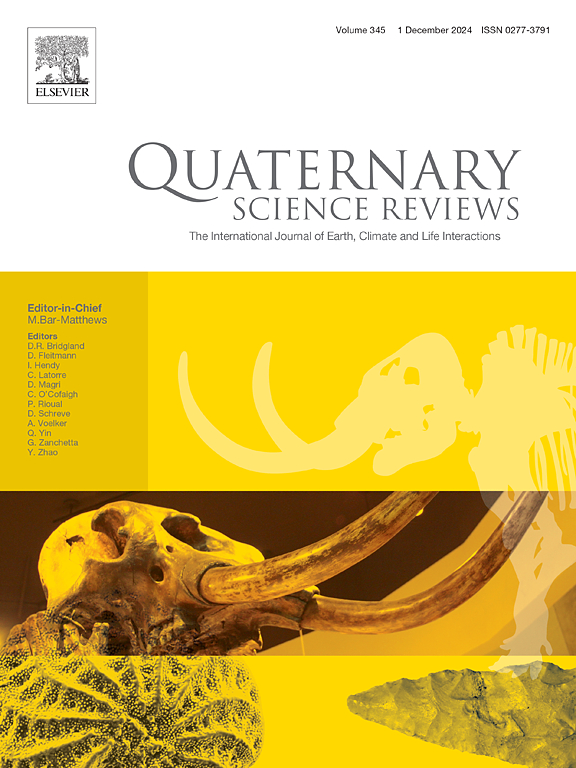Loess-paleosol sedimentological characteristics in northern Iran since the last interglacial and their paleoenvironmental significance
IF 3.2
1区 地球科学
Q1 GEOGRAPHY, PHYSICAL
引用次数: 0
Abstract
The climatic signals recorded by loess sequences vary between different regions, which makes it important to study loess sequences worldwide. The loess deposits in northern Iran are situated in the transitional zone between the European loess and Central Asian loess. However, the depositional dynamics and paleoenvironmental significance of the loess deposits in this region are not well understood, making it difficult to establish detailed correlations with loess deposits elsewhere, partly due to the lack of systematic and high-resolution chronological control. We used K-feldspar pIR50IR290 and MET-pIRIR250 luminescence dating protocols to date fifty-two K-feldspar samples from the Toshan-19 section in the northern foothills of the Alborz Mountains, northern Iran. These chronological data, along with the climate proxies of magnetic susceptibility and redness, combined with a comparison with published loess records from various regions, indicate the following: (1) K-feldspar luminescence ages obtained using pIRIR and MET-pIRIR protocols are consistent, and their luminescence ages up to ∼200 ka are deemed dependable. The loess at Toshan was primarily deposited during 78–24 ka, corresponding to MIS 4–2, and the paleosols developed during 139–78, and 24–1.7 ka, corresponding respectively to MIS 5, and late MIS 2–MIS 1. (2) Drier conditions prevailed during the last glacial and wetter conditions dominated during the last interglacial. Moisture variations during the substages of MIS 5 in this region indicate cold-dry and warm-wet climatic characteristics. The reasons for increased moisture from late MIS 2 onwards in this region still require further investigation. (3) The loess-paleosol records indicate a consistent pattern of climate change over Eurasia on the scale of the last interglacial-glacial cycle. During the substages of MIS 5, warm-wet and cold-dry conditions in northern Iran were in-phase with those on the Chinese Loess Plateau, Europe, and southern Tajikistan; however, they were anti-phased or out-of-phase with those in Xinjiang.
末次冰期以来伊朗北部黄土-页岩沉积特征及其古环境意义
不同地区黄土序列记录的气候信号不同,这对全球范围内的黄土序列研究具有重要意义。伊朗北部的黄土矿床位于欧洲黄土和中亚黄土的过渡地带。然而,由于缺乏系统和高分辨率的年代学控制,该地区的黄土沉积动力学和古环境意义尚不清楚,难以与其他地区的黄土沉积建立详细的对比。我们使用k长石pIR50IR290和MET-pIRIR250发光测年方案对伊朗北部阿尔博尔斯山脉北麓to山-19剖面的52个k长石样品进行了测年。这些年代学资料,以及磁化率和红度的气候指标,结合与各地区已发表的黄土记录的比较,表明:(1)用pIRIR和MET-pIRIR协议获得的k -长石发光年龄是一致的,其发光年龄可达200 ka。托山黄土主要沉积期为78 ~ 24 ka,对应MIS 4-2;古土壤发育期为139 ~ 78 ka和24 ~ 1.7 ka,分别对应MIS 5和MIS 2 ~ MIS 1晚期。(2)末次冰期以干燥为主,末次间冰期以湿润为主。该地区MIS 5亚阶段的湿度变化具有干冷和暖湿的气候特征。从MIS 2后期开始,该地区湿度增加的原因仍需进一步调查。(3)黄土-古土壤记录显示了末次间冰期-冰期旋回尺度上欧亚大陆气候变化的一致性。在MIS 5次级阶段,伊朗北部的暖湿和冷干条件与中国黄土高原、欧洲和塔吉克斯坦南部的暖湿和冷干条件处于同一阶段;然而,它们与新疆的相反或相异。
本文章由计算机程序翻译,如有差异,请以英文原文为准。
求助全文
约1分钟内获得全文
求助全文
来源期刊

Quaternary Science Reviews
地学-地球科学综合
CiteScore
7.50
自引率
15.00%
发文量
388
审稿时长
3 months
期刊介绍:
Quaternary Science Reviews caters for all aspects of Quaternary science, and includes, for example, geology, geomorphology, geography, archaeology, soil science, palaeobotany, palaeontology, palaeoclimatology and the full range of applicable dating methods. The dividing line between what constitutes the review paper and one which contains new original data is not easy to establish, so QSR also publishes papers with new data especially if these perform a review function. All the Quaternary sciences are changing rapidly and subject to re-evaluation as the pace of discovery quickens; thus the diverse but comprehensive role of Quaternary Science Reviews keeps readers abreast of the wider issues relating to new developments in the field.
 求助内容:
求助内容: 应助结果提醒方式:
应助结果提醒方式:


